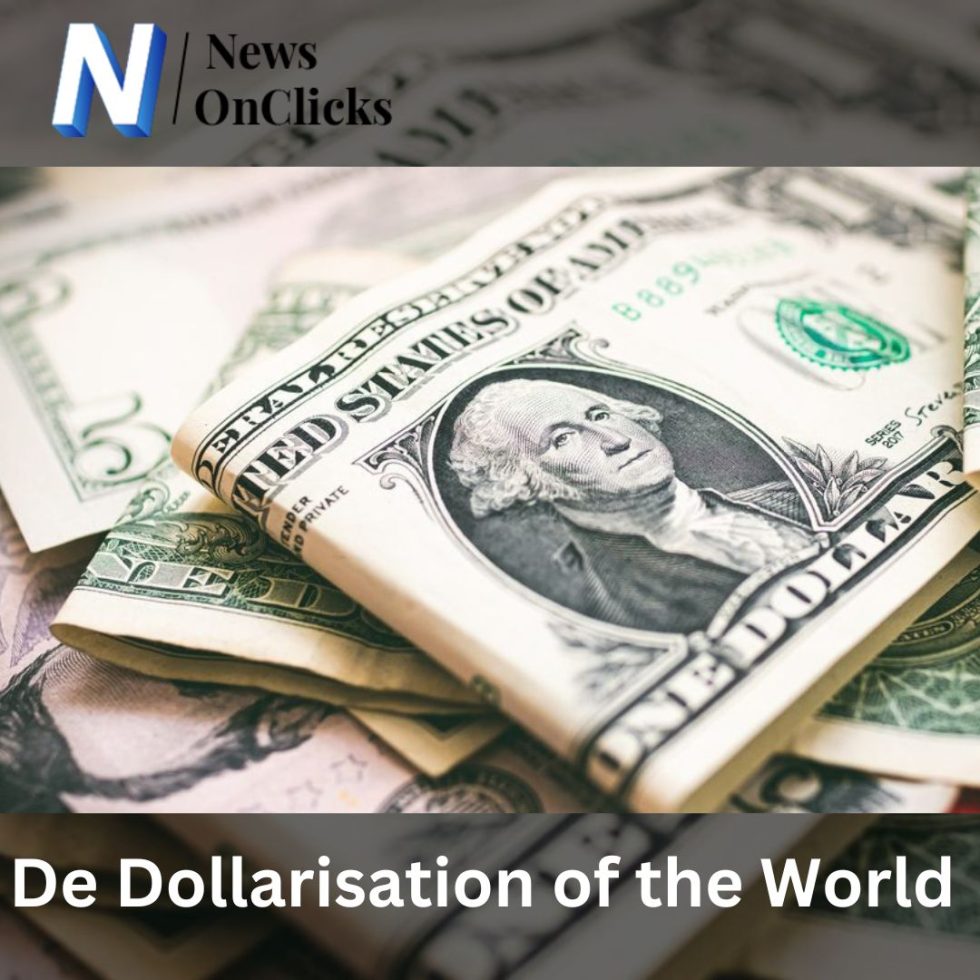
As per the Analyst of America’s biggest bank, JP Morgan, “Some signs of de-dollarization are emerging and this trend is likely to persist.”
Both the English language and dollars have their own importance globally. In addition to five US territories, 11 more countries have adopted the dollar as their official currency.
Apart from this, dollars are used to exchange goods and services within nations. Currently, 70% of global trade is conducted using the US Dollar.
The whole world is relying on the US dollar to trade to some extent. To reduce this reliance on the US dollar, Steps for de-dollarization are being taken by many countries including India.
De-dollarization is the process of replacement of the US dollar for international trade. It would be substituted by gold and digital currency. This term would be new but the demand for it has been rising for decades. Last year, China and Brazil decided to trade with their domestic currency.
Advantages of de-dollarization
Reduce dependency on the US dollar – By using other currencies, countries can reduce their dependence on the US dollar which helps to mitigate the impact of economic and political changes in the US on their own economy.
Diversification of Global Reserve currency – De-dollarization leads to reducing the exposure to dollar fluctuations by increasing the holding of gold, the rupee will enhance their monetary sovereignty.
Strengthening regional cooperation and integrity – By forming alliances and blocks that challenge the US-led order. For example, BRICS countries established a contingent reserve arrangement (CRA) for mutual support in times of BOP crisis.
Challenges from De-dollarization
Reduced Liquidity and Efficiency of global markets – The US Dollar is widely used in international transactions. If countries shift away from the Us dollar, the liquidity will be reduced and result in increased transaction costs.
Increased Geopolitical tension and instability – It leads to shifts in global capital flows and fluctuating exchange rates.
Limited innovation and growth opportunities for startups – Countries’ access to capital from international investment is possible only when countries rely on US market-based platforms otherwise only regional and domestic investment limits growth.
Limited use of national currencies in international trade – De-dollarization leads to the use of national currency for international trade. It makes it hard for national currencies to compete in the international world.
Monetary sovereignty – Hegemonic role of dollars limits the monetary sovereignty of other countries by making it difficult to use monetary policy to stabilize economies.
As per the Analyst of America’s biggest bank, JP Morgan, “Some signs of de-dollarization are emerging and this trend is likely to persist.”
Both the English language and dollars have their own importance globally. In addition to five US territories, 11 more countries have adopted the dollar as their official currency.
Apart from this, dollars are used to exchange goods and services within nations. Currently, 70% of global trade is conducted using the US Dollar.
How has the US dollar become the international currency?
At the time of world war II, major countries that fought had suffered huge losses in their mainland but the US had not got much loss except the attack of Japan on pearl harbor. The economic situation of many countries has gotten very bad. To rebuild the infrastructure and other things, the US gave a little assistance to a few countries. And those countries paid back in US dollars.
After World War II, an agreement was made at the Bretton wood conference. Under the Bretton wood agreement, counties can take funds from the IMF and World Bank but it must be returned in US dollars.
Before the second world war, most of the international trade was done in exchange for gold. The US has a three fourth of the total gold supply of the world. This is also an advantage, the US has.
Hence, the US Dollar will keep a significant hold in the global market till the above factors continue to remain in play.
Steps India is taking towards de-dollarization
- The Reserve Bank of India unveiled a rupee settlement system for international trade.
- Banks from 18 countries are allowed by RBI to open Special Rupee Vostro Accounts (SRVAs) to settle payments in Indian rupees.
- RBI signed an agreement to extend up to USD 200 million currency swap facility to Maldives Monetary Authority.
- In 2020, India and Japan entered and expanded their currency swap arrangement into Indian rupees and Japanese yen.
- Being a member of SAARC, India is promoting the use of local currencies within the SAARC region.
- India is promoting a cross-border digital payment system between India and the UAE through a remittance facility.
Final Words
De-dollarization is not a quick and easy task. It involves complex coordination and cooperation among countries as well as risk and costs. Therefore countries should be cautious in strengthening their domestic financial system.









